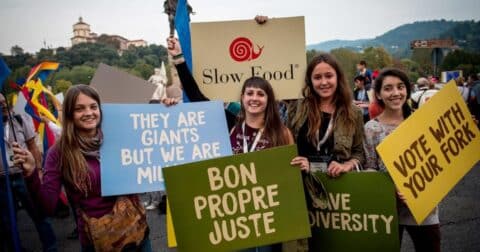News
Costco Chicken Processing Plant Keeps Failing Tests for Salmonella
Food•5 min read
Explainer
The global movement is against factory farming — and is also against one of its potential solutions.


Words by Gabriella Sotelo
It started with protesters, equipped with bowls of penne, standing against a McDonald’s near the Spanish Steps in Italy. The protest, organized by Carlo Petrini in 1986, in part protested the values associated with fast food, but also the standardization of food around the world. This was the birth of what’s known as the slow food movement.
The slow food movement has evolved since then, promoting local food and traditions, as well as quality food production over industrialized factory farming, which dominates our global food system. “The whole idea [of slow food] is that food is more than just what we eat,” Professor Marie Orton told Brigham Young University. “In the Slow Food Manifesto, it says ‘good food is a human right.’”
The movement has slowly gained traction since 1986. Though there is still a McDonald’s close to the Spanish Steps, the slow food movement has expanded to become a global movement with a presence in 160 countries. The movement has been involved in the planning of the United Nations Climate Change Conference, had representatives at the UN Convention on Biological Diversity — and rejected an invitation to the UN Food Systems Summit, instead taking part in a counter mobilization that was attended by 9,000 people virtually.
Proponents of slow food are active participants in food systems discussions, including panels and conventions. At next week’s Climate Week NYC for instance, a number of panels hosted by Food Tank will explore the intersections of food, sustainability and climate action, and two will include Alice Waters, a founding member of the slow food movement, to discuss the future of food.
Slow Food envisions a world where everyone can access food that is not only good for their health, but is also beneficial for the communities that grow it, and the planet as a whole. Central to this vision is the promotion of agroecology, a movement that aims to integrate ecological principles into farming practices.
Agroecology proponents argue that their practices are more “natural” and therefore more sustainable. Critics have long countered that agroecological farms end up requiring more natural resources, including land. These are the tradeoffs that spark vigorous food system debates — land left uncultivated, like in a forest, can store more carbon to keep climate pollution out of the atmosphere.
The slow food movement does not call for the elimination of meat — the largest driver of food-related climate emissions — but the organization does recommend eating less.
Described as a “slower” approach to meat and dairy production, the points echo what is often called the “less meat, better meat” strategy. Research from the World Resources Institute published in April documented a complicated paradox for this strategy. In a nutshell, farms that are “better” for animals may very well not be better for climate pollution, and vice versa.
The slow food movement published their Plant the Future report almost a year ago as an outline for their vision of food system transition — one that favors eating more plants and better treatment of farm animals.
A healthy diet, by the slow food movement’s definition, is one that respects the planet, is minimally processed, is produced using sustainable methods and favors whole plant foods. Being environmentally friendly means a shift away from industrial animal farming, or as they put it, “less meat, more beans.”
Still, the movement is not calling for veganism, or even vegetarianism. You can find proponents of slow food still enjoying a steak (Alice Waters even sells it at her restaurant), and it also rejects cultivated meat — a potential solution to factory farming. According to slow food advocates, it is the overconsumption of meat, and the way in which it is produced, that advocates of slow food view as the problem.
In the report, the authors note that the Global North over-consumes animal products, while many around the world are not even guaranteed food. The report argues that “the increase in the consumption of food of animal origin from factory farming and intensive fishing in recent decades has been detrimental to food security and human health, disastrous for animal welfare, and has contributed greatly to the climate emergency.”
While meat is still on people’s plates in the slow food ideal, proponents do call for a transition to a plant-rich diet. Industrial meat production has to be challenged, they write, but with an increase in production and consumption of foods like legumes, vegetables and whole grains.
The movement also rejects the idea of lab-grown meat. Even though cultivated meat does less harm to the environment and local communities than the industrial meat industry, proponents of slow food argue that it is removed from nature, and does not allow a relationship between consumer and producer.
The slow food movement defines food justice as “a holistic and structural view of the food system that sees healthy food as a human right and addresses structural barriers to that right.”
That sounds good — but in practice, the reality is, not everyone has an equal opportunity to participate in the slow food movement.
For the slow food movement, “fair” food systems are defined as: a solidarity economy which has fair pay and fair working conditions for workers producing the food, the inclusion of Indigenous people, farmers, food producers and others in decision making and respecting their expertise, and respecting animals as sentient (despite still eating them).
The movement has been described by academics as privileged, since it frequently promotes foods that are unavailable and unaffordable to many low-income individuals.
For low-income neighborhoods and households that are located in what researchers have dubbed “food deserts” — areas where residents have difficulty accessing nutritious and affordable fresh foods — practicing the ideals of the slow food movement may be difficult. In 2019, 11 to 27 percent of the U.S. lived in low-income areas with limited access to supermarkets.
Some studies have found that lower-income neighborhoods have a higher proportion of fast-food restaurants than high income neighborhoods, and that wealthier neighborhoods are more likely to offer healthier foods (though other studies find the wealthy eat plenty, if not more, fast food). Fast food is key for people struggling to get by, especially if the cost of “good and clean” foods are higher.
The Plant the Future report notes that access can be a concern for people who live in low income areas, stating, “Proteins, whether of plant or animal origin, cannot be good and clean if they are not also fair for everyone, and thus both affordable for consumers and capable of providing a dignified living to producers.” But the report does not offer a solution when it comes to making slow food affordable for all.
That said, some slow food chapters in the U.S. have begun hosting events that are more accessible, and in 2008, the group at least sought to scrutinize its own privilege. One chapter in Sonoma County hosts low-cost or free events, while other gatherings are informal, like a potluck hosted at a member’s house.
Accessing events hosted by Slow Food USA and its chapters can cost time and money, which not everyone has. And while farmers markets have become slightly more accessible by accepting SNAP (food stamps), restaurants that promote slow food are usually prohibitively expensive.
Alice Waters, the pioneer of the slow food movement in the United States, is a perfect example. Waters’ restaurant Chez Panisse is for the elite; a four-course meal is set at $175.
In 2017, Slow Food USA created an Equity, Inclusion, and Justice Working Group to recognize injustice within the food system. This includes recognizing the exploitation of workers in the system, the lack of access to healthy foods and better understanding food deserts.
Hnin W. Hnin worked at Slow Food USA and wrote about how many families, like their own, hadn’t heard of the movement — but have been practicing many of its values nonetheless.
When they went to work for Slow Food USA, Hnin wanted to explore how to bridge the gap between food movements and social justice movements. Hnin writes that there is “pleasure and justice in the simple belief that all communities should have the right to delicious, sustainable, and ethically sourced food that resonates with their identity, culture, and history.”
The slow food movement did not stop after that protest near the Spanish Steps; it continues to develop. Ultimately, according to Hnin, if the movement wants to challenge industrial agribusiness and other factors like environmental degradation or race, class and gender inequities, it needs groups to work together.